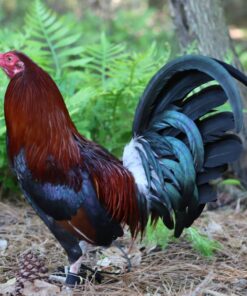Radio chicken
$300.00 – $1,200.00
Reasons To Buy
- Fast delivery to any location
- Secure payments
- Eco-friendly manufacturing
Radio Chickens
The Fierce Fighters of Gamefowl Tradition
In the world of gamefowl, certain bloodlines have carved a lasting legacy due to their strength, intelligence, and battle-tested performance. One such legendary line is the Radio chicken — a breed known for its agility, cutting ability, and unmatched game spirit. While not as widely recognized outside the community of breeders and cockfighting enthusiasts, the Radio bloodline holds a place of honor among elite gamefowl strains.
Origins of the Radio Bloodline
The Radio chicken bloodline originated in the United States, with its roots tracing back to the early 20th century. Though exact origins are debated, it is widely believed that the bloodline was developed by a breeder named Cecil Davis or possibly Jim Clem, depending on differing accounts. The name “Radio” reportedly comes from a rooster that was named after a popular radio station at the time.
This original Radio rooster demonstrated superior fighting ability and was bred extensively to preserve and enhance its traits. Over time, the Radio line was carefully crossed with other top gamefowl strains such as Sweater, Kelso, and Hatch to increase performance, speed, and intelligence in the pit.
Key Characteristics of Radio Chickens
Radio gamefowl are admired for a number of traits that make them highly competitive:
-
Appearance: Radios typically have dark red feathers with black tail and wing tips. They often have yellow legs and pea or straight combs.
-
Fighting Style: They are known for being aggressive, high-flying cutters. Radios tend to fight smart — they are not just brawlers, but strategic in their attacks.
-
Endurance: Radios have great stamina and heart, often turning fights around even when at a disadvantage.
-
Crossing Ability: Radio blood mixes well with other lines, making it a favorite for creating hybrid crosses. Radio x Sweater and Radio x Kelso are especially popular.
The Role of the Radio Hen
Just like any elite bloodline, the Radio hen plays a crucial role in maintaining the quality of the breed. Breeders look for hens that show sharpness, alertness, and strong maternal instincts. A good Radio hen not only passes down desirable traits but also helps balance temperament in crossed lines.
Popularity Around the World
The Radio line has become especially popular in the Philippines, Mexico, and Latin America, where legal cockfighting remains part of traditional culture. Filipino breeders, in particular, have refined the Radio line through selective breeding, adapting them for short knife (tari) fighting — a popular form of competition in the country.
In these regions, Radio gamefowl are often seen in derbies and tournaments, where their impressive speed and cutting ability make them crowd favorites.
Ethical Considerations
It’s important to acknowledge that cockfighting is illegal or heavily restricted in many countries, including most of the United States. While the breeding and raising of gamefowl is legal in many areas, using them for fights may not be.
In recent years, some breeders have shifted toward raising these birds for show or preservation purposes, focusing on their beauty, lineage, and heritage rather than combat.
Conclusion
Radio chickens are more than just a fighting breed — they are the result of decades of careful breeding, strategy, and tradition. Known for their game spirit, intelligence, and adaptability, Radio gamefowl remain a respected and valuable bloodline in the world of gamefowl breeding. Whether kept for competition, breeding, or preservation, the Radio line continues to stand the test of time as a symbol of strength, heart, and heritage.
| Select Fowl | Pairs, Pullets, Stags, Trio |
|---|---|
| Gender | Female, Male |
Be the first to review “Radio chicken” Cancel reply
Related products
GAME FOWLS FOR SALE
GAME FOWLS FOR SALE
Fighting Roosters
GAME FOWLS FOR SALE
Fighting Roosters
Fighting Roosters
Fighting Roosters
Fighting Roosters













Reviews
There are no reviews yet.